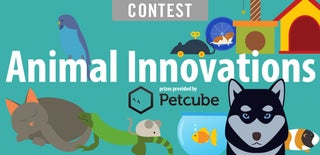Introduction: Automated Dog Feeder
PLEASE CLICK VOTE IF YOU LIKE THIS ENTRY:
I know that feeding time is a great way to bond with your pet, but I really wanted to automate the process; especially in the morning! These instructions will outline the components I used to construct the build, as well as some of the pitfalls I had to overcome. The feeder is certainly not perfect and the next version would be different/better, but the building and planning stages have been lots of fun. Please have a look at the images and videos to help get a sense of the feeder.
There are two aspects to the feeder: the main chamber(s) feed dry food and the smaller motor dispenses a treat between major feeds. The main chamber is driven by a stepper motor and the treat is driven by a servo motor.
Step 1: Components
MOTORS
1 high torque nema 17 stepper motor (high torque is necessary to turn the feeder when ALL of the chambers are full)
1 servo motor.
ARDUINO
1 Arduino MEGA and 2 Arduino UNO boards.
1 Motor shield from Adafruit for the UNO board.
1 Ethernet shield for the UNO board and an Apple Airport Express base station.
SERVO CITY (www.servocity.com)
2 hub sprockets and chain from ServoCity.
Numerous channel lengths to construct the major structure; purchased from ServoCity.
Clamping hubs, collars, Shafts and shaft couplers, bearing mounts.
HARDWARE
Acrylic to be laser cut in order to construct the central feeding wheel.
3 arcade style buttons.
1 TFT LCD display to indicate feeding times.
1 RTC (real time clock) to help keep track of time.
Step 2: Laser Cut Parts
I have attached a CorelDraw X3 file to build the central wheel; note that there are 8 separate chambers providing for multiple feeding sessions. As you zoom out of the document, you will note the parts needed to make each chamber side.
Attachments
Step 3: Code
There are three Arduino boards used to construct the feeder:
Arduino MEGA (Chrono_Board)
Arduino UNO (Motor_Shield)
Arduino UNO (Ethernet_Shield)
NOTE: The pitches.h file is associated with the Motor_Shield file; it contains the necessary details for audio to be played when feeding takes place. It is the PACMAN theme song!
Step 4: Camera
I connected a Dlink camera to give real-time feedback on whether or not a feed was dispensed or not; both audio and video. A motion detection area can be configured to send an email when it detects movement during both day and night.
Step 5: Wifi and App
In order to make the feeder versatile, I added remote feeding as an option. To do this, I hooked up the Wifi shield to an Apple AirPort Express. For this to work, I used the API service put together by Nathan Kennedy on https://www.teleduino.org/ I can now remotely supply both dry food and/or a special treat via my iPhone or any other device that has internet access!
NOTE: It is well worth looking at Nathan's website to fully understand how his FREE service works.
Step 6: Schematics
The fritzing wiring diagram is now up! It took a while, and I'm sure there are easier ways of completing the task but this is what I did! Feel free to download it via the link below and ask questions if you need help.
Attachments
Step 7: Next..........
When I first mounted the feeder to the wall, I came home one day and Katie was enormous. She had eaten three days of food in one hit! I tried to construct an outer barrier to the main feeding chamber to no avail.........I set up a camera and tripod to capture her 'hack' the feeder; see the attached video of her in action. In the end I had to raise the entire feeder far beyond her reach as seen in the final photo. To minimise the food bouncing all over the place, I added a new pipe to funnel the food down into the bowl with better precision.

Participated in the
Animal Innovations Contest














